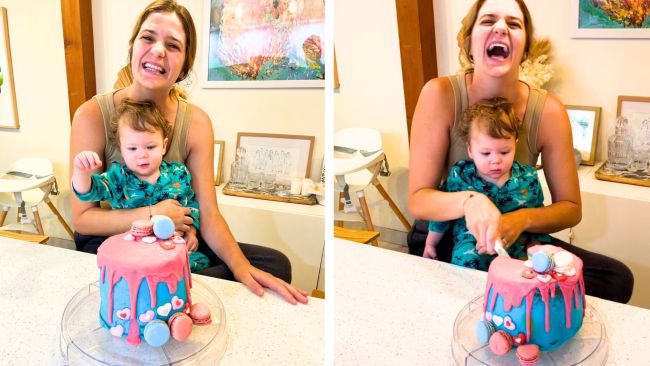How to treat a C-section pouch, according to a GP
What every new mum can do to take care of their postpartum belly.

Pregnancy
Don't miss out on the headlines from Pregnancy. Followed categories will be added to My News.
A C-section is one way to meet your baby, which is the most important factor, but there’s no denying that it puts a lot of pressure on your body. The healing process takes time and your body will feel and look different after birth.
While this is completely normal and expected, it’s also understandable if these changes take some time to get used to. One such change is the development of a C-section pouch, where fat deposits and excess skin appear near your incision scar.
Understanding the cause of the C-section pouch and ways you can treat it may feel like a small step to feeling more comfortable in your postpartum body.
With the help of Kin Fertility GP, Dr Kirsty Wallace-Hor, we’re exploring everything related to the C-section pouch and how to take care of your body during one of the most exciting and demanding times in your life.
Want to join the family? Sign up to our Kidspot newsletter for more stories like this.
RELATED: My MIL wants to deliver my baby – for the dumbest reason
What is a C-section pouch?
As far as medical procedures go, a C-section is a major surgery. While life becomes very busy after birth, it’s important to take the time to rest and recover where you can.
But, what does this procedure actually entail? Well, Dr Wallace-Hor is here to explain because, as she puts it, “understanding the surgery and potential complications can help optimise your recovery”.
According to Dr Wallace-Hor, “a C-section involves cutting several different layers to reach the uterus — including skin, the fatty tissue under the skin and the fascia (the connective tissue that holds organs, muscles, bones and nerve fibres in place)”.
“This necessarily leads to the formation of scar tissue which, when coupled with the normal weakening of core muscle strength that happens during pregnancy, can lead to a C-section pouch or shelf — the bulge we often see persisting after giving birth.”
So, while a C-section pouch isn’t anything to worry about when it comes to your health, it’s understandable if you’d like to explore ways to reduce its appearance.

RELATED: Mum with two uteruses conceives twins days apart
What to do in the weeks after a C-section birth
While we are running the risk of sounding like a broken record, it’s important to reiterate just how significant rest is — especially in the 6-8 weeks following a C-section birth. Your body has gone through a massive procedure and it needs as much downtime as possible.
Plus, it’s literally doctor’s orders! And, it’s not just about physical recovery for your incision area but rest is also crucial if you’re breastfeeding.
“I encourage my patients to rest, delegate tasks (such as laundry and cooking) as much as you can to family and friends, avoid heavy lifting and concentrate on eating well and keeping hydrated,” says Dr Wallace-Hor. “This is particularly important when breastfeeding as this will help with breastmilk supply.”
This is often a physically, mentally and emotionally challenging time so be kind to yourself. While there’s not much you can do right now, you can prioritise your healing process, which in turn, means you can start treating your C-section pouch in a few weeks.
“Even if you had a smooth pregnancy and delivery, all the postpartum hormone changes and emotions can be a bit of rollercoaster so it’s important to be gentle with yourself and acknowledge what an amazing feat your body has achieved,” says Dr Wallace-Hor.
Caring for your C-section pouch going forward
It’s around the 6-week mark when you can start thinking about ways to treat your incision scar.
Dr Wallace-Hor explains: “Provided you haven’t had any complications, it’s a good time to turn your mind to scar management and abdominal muscle strengthening — both will help reduce a C-section pouch”.
The good news is that the steps to caring for your incision area after the 6-8 week mark are pretty straightforward. The main goal is to keep the scar flat and mobile, which you can do with certain types of tape.
“Using silicone gel or tape can help reduce the risk of a raised scar (usually referred to as a hypertrophic or keloid scar), and massage will help reduce tethering of the scar to the muscles,” says Dr Wallace-Hor. “It’s this tethering which makes the overlying skin and fat more obvious, creating the pouch.”
Massage is also a handy tool in the care routine for your scar and it’s also helpful for the treatment of a C-section pouch. It can feel intimidating starting this process on your own — and that is totally understandable! — so you might want to consider reading out to a healthcare professional for assistance if you can.
Dr Wallace-Hor explains: “Massaging your scar and lifting and moving the tissue around and below it can help reduce the appearance of the C-section pouch. Massage can also help with improving sensation in that area.
“If you’re not sure what to do, it’s worth checking in with a women’s health physiotherapist. They can also help with the postpartum core recovery by showing you exercises for your abdominal muscles. It’s also important to protect your core in the postpartum period and wearing a belly band or wrap, particularly as you gradually return to exercise, can be helpful.”
The most important thing to remember is that each person’s body will heal at different rates and you need to give both your body and mind time to recover. There is no rush and this is something that Dr Wallace-Hor emphasises.
“It’s OK if you’re not emotionally ready to start working on your body so soon after giving birth, or if you don't ever want to,” she says. “The changes our bodies go through in pregnancy can be quite variable and everyone’s recovery is different. Our body image may never be the same.
“If you have any ongoing concerns about your scar healing (such as persistent numbness, pain or infection), or if you find your recovery is affecting your mood, please see your GP.”
More Coverage
Originally published as How to treat a C-section pouch, according to a GP




